For the first time, researchers at the University of Rochester have quantified the energy of ocean currents larger than 1,000 kilometres in length. During the process, they and their collaborators discovered that the most energetic is the Antarctic Circumpolar Current, which has a diameter of about 9,000 kilometres.
Hussein Aluie, associate professor of mechanical engineering, led the team, which used the same coarse-graining technique developed by his lab to previously document energy transfer at the other end of the scale, during “eddy-killing,” which occurs when wind interacts with temporary, circular currents of water less than 260 kilometres in size.
According to lead author Benjamin Storer, a research associate in Aluie’s Turbulence and Complex Flow Group, “these new results show how the coarse-graining technique can provide a new window for understanding oceanic circulation in all its multiscale complexity.” This allows scientists to gain a better understanding of how ocean currents function as a key moderator of the Earth’s climate system.
Researchers from the University of Rome Tor Vergata, the University of Liverpool, and Princeton University are also part of the team.
Traditionally, climate and oceanography researchers have chosen boxes in the ocean ranging in size from 500 to 1,000 square kilometres. According to Aluie, these box regions, which were assumed to represent the global ocean, were then analysed using a technique known as Fourier analysis.
“The problem is that when you choose a box, you’re already limiting yourself to analysing what’s in that box,” Aluie explains. “On a larger scale, you miss everything.”
“What we mean is that we don’t need a box; we can think outside of it.”
When the researchers use the coarse-graining technique, for example, to “blur” satellite images of global circulation patterns, they discover that “we gain more by settling for less,” according to Aluie. “It enables us to disentangle different-sized ocean current structures in a systematic manner.”
He compares it to taking off your glasses and looking at a very crisp, detailed image. It will appear to be hazy. However, by looking through a series of increasing strength eyeglasses, you will often be able to detect various patterns that would otherwise be hidden in the details.
In essence, coarse graining enables researchers to quantify various structures in ocean currents and their energy “from the smallest, finest scales to the largest,” according to Aluie. Aluie credits Storer with further developing and refining the code, which has since been published for use by other researchers.

